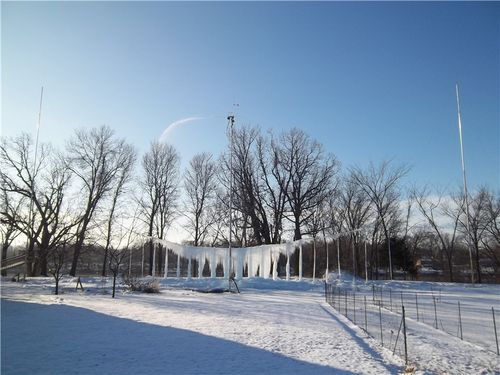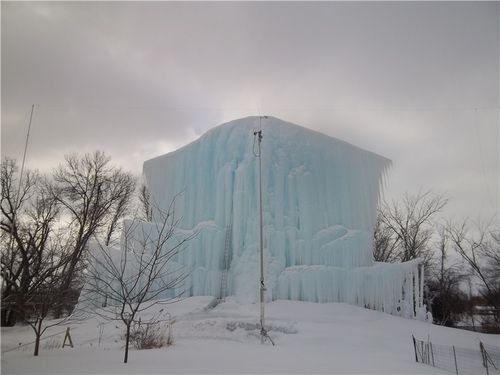Embracing winter with sculpture, the day in violence, is there a link between violence and video games, where are the Minnesota philanthropists, and no arms…no problem.
1) EMBRACING WINTER WITH SCULPTURE
Roger Hanson of Big Lake, heats his home with a geothermal system, which extracts heat from groundwater. The wastewater from these systems is usually just sent on to a river or pond. But why, when you can make sculptures out of it?
He’s rigged up a robot and system to spray the water, on steel cables, creating ice towers.
It started modestly enough, as these things do, in December…
But now, he’s got a 65-foot-high tower as of yesterday:
Here’s his website where all of this is being documented.
(h/t: Carol Lostetter )
More winter: He’s right. Shoveling is mesmerizing. Especially when someone else is doing it.
Great job by APM’s Marketplace for putting a pricetag on murder. In its excellent story about how violence in Chicago — the murder rate so far in ’13 eclipses the record-setting ’12 — is hurting the economy in one neighborhood, we learn that every homicide in the city reduces the population by 70 people. It’s estimated the violence in Chicago cost the city $2.5 billion.
And yet, some questions don’t seem to have answers:
Syron Smith is an exception to that rule. The 37-year-old office manager owns a home near Englewood with his wife, Jamika, and their 15-month old daughter, Mariah. Smith may be middle-class now, but he grew up in high rise housing projects — mostly black, mostly poor — and definitely violent.
“I was born in ’75, so I remember at 6 years old , which was ’81, asking my mom, ‘Why were blacks killing each other?'” says Smith.
It’s a question he and many others are still asking. It’s also a major reason that Smith spends almost all his free time as a community organizer, working to stop the violence in neighborhoods across the city. “The black community has to feel good again,” he says. “If you don’t feel good, you’re not trying to do nothing, you’re not motivated. With the beat down happening all the time in these neighborhoods, I tell them, ‘You’re in the oven, and the temperature’s high. When do you have time to feel good?'”
This is an outstanding — and, of course, heartbreaking – story.
Closer to home — Oakdale — a man walked down a street near his house last evening and fired — apparently randomly — at cars. He killed a 10-year-old boy.
The mayor told the Pioneer Press he didn’t want to make too many statements other than it’s a tragic situation. A police official had no such qualms.
“It’s a horrible situation, and certainly lends itself to the concern they have about gun control, and all the other kinds of issues that are being addressed right now throughout the country,” he said.
3) IS THERE A LINK BETWEEN VIOLENCE AND VIDEO GAMES?
Do violent video games lead to violence? Opinions aren’t hard to find; science is.
NPR considers why so many people like violent video games and generally gives them a pass, or at least doesn’t issue an indictment.
Gentile says we don’t know whether games turn people into murderers, because the sample size is just too small. And he notes that exposure to violent video games is likely just one part of a bigger picture.
“Take the killers at Columbine High School,” Gentile says. “They had been bullied, they had psychiatric illnesses, and yes, they also consumed a lot of media violence. No one of those things was the cause.”
“I think that people who are going to be prone to violence might be affected by video games, but I think someone who’s of sound mind is not going to be affected by a violent movie or a violent video game,” says one developer.
Coincidentally, the New York Times is tackling the same subject, and found there is an increasing treasure of data, but no one seems to know what it means.
The proliferation of violent video games has not coincided with spikes in youth violent crime. The number of violent youth offenders fell by more than half between 1994 and 2010, to 224 per 100,000 population, according to government statistics, while video game sales have more than doubled since 1996.
In a working paper now available online, Dr. Ward and two colleagues examined week-by-week sales data for violent video games, across a wide range of communities. Violence rates are seasonal, generally higher in summer than in winter; so are video game sales, which peak during the holidays. The researchers controlled for those trends and analyzed crime rates in the month or so after surges in sales, in communities with a high concentrations of young people, like college towns.
“We found that higher rates of violent video game sales related to a decrease in crimes, and especially violent crimes,” said Dr. Ward, whose co-authors were A. Scott Cunningham of Baylor University and Benjamin Engelstätter of the Center for European Economic Research in Mannheim, Germany.
Perhaps it’s a misprint. The Chronicle of Philanthropy’s 50 most charitable donors in 2012 does not list a single person who calls Minnesota home.
Jessica Cox was born without arms and she flies a plane. Now, someone wants to make a documentary about her life.
We met her four years ago over at Oshkosh.
Bonus I: Wrestling has been dropped from the Olympics. Why do we watch these things again? (CBS)
Bonus II: There’s life after the Minnesota Timberwolves, which is great news for the kids of Dayton’s Bluff. Be sure to watch the video of former player Gary Trent (Star Tribune)
TODAY’S QUESTION
President Obama reportedly plans to use his State of the Union address to call for deep cuts in the world’s nuclear arsenals. Today’s Question: Under what conditions would you support major cuts in nuclear weapons?
WHAT WE’RE DOING
I am out today but a cast of fine writers is standing by to bring you information through the day.
Daily Circuit (9-12 p.m.) – First hour: Personal finance writers Kelli Grant and Farnoosh Torabi on financial advice for people in their 20s and 30s. (Rebroadcast)
Second hour: Financial planner Ruth Haydn. (Rebroadcast)
Third hour: Don Barlett and James Steele discuss their book “The Betrayal of The American Dream” (Rebroadcast).
MPR News Presents (12-1 pm): It’s Abraham Lincoln’s birthday: Hear a Doris Kearns Goodwin “TED Talk” about Lincoln (2008) . Part 2: Extended excerpt from the BBC documentary, “Hillary Clinton’s Journey.”
Talk of the Nation (1-2 p.m.) – Defense spending takes up a huge chunk of the federal budget, so whether the sequester takes effect on March first or not, the Pentagon’s purse is on the line. Weapons procurement, force levels, health and retirement benefits. Former Pentagon official Michele Flournoy and NPR’s Tom Bowman discuss the future of funding the Department of Defense.
All Things Considered (3-6:30 p.m.) – – If you need food or other help in Hennepin County right now, finding the time and transportation to get it can be tough. You often have to go to downtown Minneapolis to apply, or run around to various places. Hennepin County aims to change that, by opening six human services “hubs” in different parts of the county. MPR’s Julie Siple will have the story.
It seems impossible, but on Lake Superior there’s a thriving scene of about 50 surfers who brave the frigid water for waves they swear can compare to some of the best surfing in Hawaii or California. MPR’s Dan Kraker investigates.
Dan Olson provides a profile of the Hawaiian Lau Collective, formed by Kim Sueoka and David Burke who are also members of the Rose Ensemble.
Fifty years ago, the Kennedy White House celebrated Lincoln’s birthday and the Emancipation Proclamation with a who’s-who of black Americans. But there was one glaring exception: Martin Luther King stayed away. NPR will have that story.


